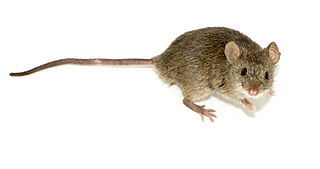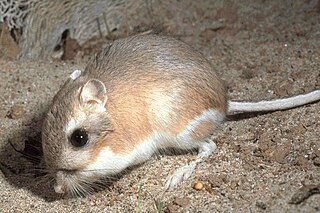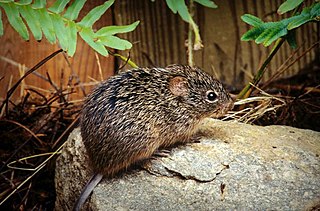
A mouse is a small mammal. Characteristically, mice are known to have a pointed snout, small rounded ears, a body-length scaly tail, and a high breeding rate. The best known mouse species is the common house mouse. Mice are also popular as pets. In some places, certain kinds of field mice are locally common. They are known to invade homes for food and shelter.

Rats are various medium-sized, long-tailed rodents. Species of rats are found throughout the order Rodentia, but stereotypical rats are found in the genus Rattus. Other rat genera include Neotoma, Bandicota and Dipodomys.

Moles are small mammals adapted to a subterranean lifestyle. They have cylindrical bodies, velvety fur, very small, inconspicuous eyes and ears, reduced hindlimbs, and short, powerful forelimbs with large paws adapted for digging.

The black rat, also known as the roof rat, ship rat, or house rat, is a common long-tailed rodent of the stereotypical rat genus Rattus, in the subfamily Murinae. It likely originated in the Indian subcontinent, but is now found worldwide.

Kangaroo rats, small mostly nocturnal rodents of genus Dipodomys, are native to arid areas of western North America. The common name derives from their bipedal form. They hop in a manner similar to the much larger kangaroo, but developed this mode of locomotion independently, like several other clades of rodents.

The rodent subfamily Rhizomyinae includes the Asian bamboo rats and certain of the African mole-rats. The subfamily is grouped with the Spalacinae and the Myospalacinae into a family of fossorial muroid rodents basal to the other Muroidea.

The bamboo rats are four species of rodents of the subfamily Rhizomyinae. They are the sole living representatives of the tribe Rhizomyini. All are found in South Asia, Southeast Asia and East Asia.

Ground squirrels are members of the squirrel family of rodents (Sciuridae), which generally live on or in the ground, rather than trees. The term is most often used for the medium-sized ground squirrels, as the larger ones are more commonly known as marmots or prairie dogs, while the smaller and less bushy-tailed ground squirrels tend to be known as chipmunks. Together, they make up the "marmot tribe" of squirrels, Marmotini, a division within the large and mainly ground squirrel subfamily Xerinae, and containing six living genera. Well-known members of this largely Holarctic group are the marmots (Marmota), including the American groundhog, the chipmunks, the susliks (Spermophilus), and the prairie dogs (Cynomys). They are highly variable in size and habitus, but most are remarkably able to rise up on their hind legs and stand fully erect comfortably for prolonged periods. They also tend to be far more gregarious than other squirrels, and many live in colonies with complex social structures. Most Marmotini are rather short-tailed and large squirrels. At up to 8 kg (18 lb) or more, certain marmots are the heaviest squirrels.
Susan Hawk is a reality TV personality, actress, and truck driver who was a contestant on Survivor: Borneo and Survivor: All-Stars.

The Tribe is a science fiction drama television series which premiered on Channel 5 in the United Kingdom on 24 April 1999. The series was created by Raymond Thompson and Harry Duffin, and was developed and produced by the Cloud 9 Screen Entertainment Group in New Zealand. The series was commissioned by Channel 5, who received the initial screening rights. The series made its New Zealand premiere in 2000 on TV4.

The Old World rats and mice, part of the subfamily Murinae in the family Muridae, comprise at least 519 species. Members of this subfamily are called murines. In terms of species richness, this subfamily is larger than all mammal families except the Cricetidae and Muridae, and is larger than all mammal orders except the bats and the remainder of the rodents.

The rodent subfamily Sigmodontinae includes New World rats and mice, with at least 376 species. Many authorities include the Neotominae and Tylomyinae as part of a larger definition of Sigmodontinae. When those genera are included, the species count numbers at least 508. Their distribution includes much of the New World, but the genera are predominantly South American, such as brucies. They invaded South America from Central America as part of the Great American Interchange near the end of the Miocene, about 5 million years ago. Sigmodontines proceeded to diversify explosively in the formerly isolated continent. They inhabit many of the same ecological niches that the Murinae occupy in the Old World.

The New World rats and mice are a group of related rodents found in North and South America. They are extremely diverse in appearance and ecology, ranging in from the tiny Baiomys to the large Kunsia. They represent one of the few examples of muroid rodents in North America, and the only example of muroid rodents to have made it into South America.

The cloud rats or cloudrunners are a tribe (Phloeomyini) of arboreal and nocturnal herbivorous rodents endemic to the cloud forests of the Philippines. They belong to the family Muridae and include five genera: Batomys, Carpomys, Crateromys, Musseromys, and Phloeomys. They range in size from as large as 50 cm (20 in) to as small as 74 mm (2.9 in). Cloud rats are threatened by habitat loss and illegal hunting. Several species are endangered or critically endangered.
The montane fish-eating rat is a species of semiaquatic rodent in the family Cricetidae. It inhabits the Andes Mountains of Colombia and Ecuador.

Rodents are mammals of the order Rodentia, which are characterized by a single pair of continuously growing incisors in each of the upper and lower jaws. About 40% of all mammal species are rodents. They are native to all major land masses except for New Zealand, Antarctica, and several oceanic islands, though they have subsequently been introduced to most of these land masses by human activity.

Transandinomys is a genus of rodents in the tribe Oryzomyini of family Cricetidae. It includes two species—T. bolivaris and T. talamancae—found in forests from Honduras in Central America south and east to southwestern Ecuador and northwestern Venezuela in northern South America. Until 2006, its members were included in the genus Oryzomys, but phylogenetic analysis showed that they are not closely related to the type species of that genus, and they have therefore been placed in a new genus. They may be most closely related to genera like Hylaeamys and Euryoryzomys, which contain very similar species. Both species of Transandinomys have had eventful taxonomic histories.

Rat meat is the meat of various species of rat: medium-sized, long-tailed rodents. It is a food that, while taboo in some cultures, is a dietary staple in others. Taboos include fears of disease or religious prohibition, but in many places, the high number of rats has led to their incorporation into the local diets.

Rat-on-a-stick, also referred to as rat kebab, is a dish or snack consisting of a roasted rat served on a stick or skewer. The dish is consumed in Thailand and Vietnam. Prior to roasting, the rat is typically skinned and washed, after which it is gutted to remove its internal organs and then roasted.

Echimyinae is a subfamily of rodents belonging to the spiny rats family Echimyidae. It contains 14 arboreal genera—all the members of the tribe Echimyini, plus Callistomys—a few terrestrial genera, and a subaquatic genus (Myocastor).















